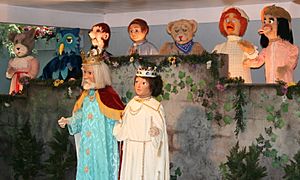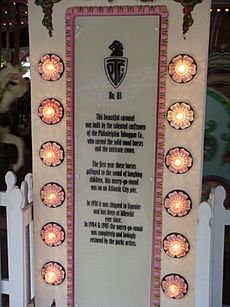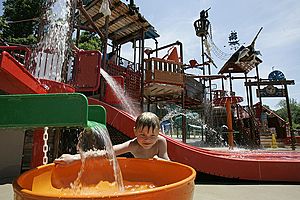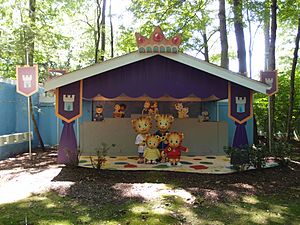Idlewild and Soak Zone facts for kids
| Previously known as Idlewild Park | |
 |
|
| Location | Ligonier, Pennsylvania, United States |
|---|---|
| Coordinates | 40°15′40″N 79°16′53″W / 40.26111°N 79.28139°W |
| Opened | 1878 |
| Owner | Parques Reunidos |
| Operated by | Palace Entertainment |
| Attractions | |
| Total | 40 |
| Roller coasters | 2 |
| Water rides | 16 |
| Website | www.idlewild.com |
Idlewild and Soak Zone, often called Idlewild Park, is a fun amusement park for kids. It's located in the Laurel Highlands near Ligonier, Pennsylvania, in the United States. This park is about 50 miles (80 km) east of Pittsburgh, right along US Route 30.
Idlewild was started way back in 1878 as a campground by Thomas Mellon. This makes it the oldest amusement park in Pennsylvania. It's also the third oldest park still running in the entire United States! The park has won many awards, including being named the best children's park in the world by Amusement Today.
The park was owned by the famous Mellon family for over 100 years. It grew a lot in the early 1900s, adding rides like the Rollo Coaster in 1938. Idlewild is also home to the Ligonier Highland Games, a big Scottish festival that attracts over 10,000 people every year. In 1983, the park was bought by Kennywood Entertainment Company. They added new attractions, including one based on Mister Rogers' Neighborhood, designed and voiced by Fred Rogers himself! Since 2008, Idlewild has been owned by a Spanish company called Parques Reunidos. It is operated by their American company, Palace Entertainment.
Contents
Park History: How Idlewild Began
The Railroad Years: 1878–1952
In 1853, a company got permission to build a railroad to carry coal and timber. This railroad would connect Ligonier and Latrobe. After some delays, the company became the Ligonier Valley Railroad in 1871.
In 1875, a retired judge named Thomas Mellon bought the railroad. He owned banks and was involved in many businesses. To get more people to ride his trains, Mellon decided to create a fun place along the railway.
In 1878, William Darlington agreed to let Mellon use his land for picnics and pleasure. The first building was a small train station. Soon, the park had campsites, a lake for fishing and boating, and picnic areas. The railroad made it easy for people from Pittsburgh and nearby areas to visit. On July 4, 1890, so many people came that the "tops of the coaches were covered with boys!"
The park grew, adding three lakes between 1880 and 1896. In 1896, a steam carousel was added. By the end of the 1800s, Idlewild offered bike paths, hiking trails, fishing, and rowboating. It also had dining halls, auditoriums, and athletic fields.
In 1931, Judge Mellon's son, Richard B. Mellon, and C. C. Macdonald took over the park. They brought electricity to Idlewild, allowing for longer hours and electric rides. A new Philadelphia Toboggan Company carousel was added. The park also got a den of black bears that year.
The Macdonalds wanted to keep the park beautiful. They planted thousands of shrubs and trees. In the 1930s, new rides like a circle swing, a Whip, and a miniature railroad were added. In 1938, the famous Rollo Coaster opened. The park closed in 1943 because of World War II. When it reopened in 1946, it added the Caterpillar and a small showboat.
The Macdonald Family Era: 1952–1983
The Macdonald family fully owned the park by 1951. The Ligonier Valley Railroad stopped running in 1952. However, this didn't affect the park much. The Lincoln Highway, a major road, passed right by Idlewild. More and more people were driving to the park.
Under the Macdonalds, the park kept growing. Kiddieland was built between 1954 and 1956. It had smaller versions of rides just for children, like miniature boats and a Ferris wheel.
Clinton "Jack" Macdonald became the park's president in 1957. In 1959, he helped start the Ligonier Highland Games at the park. This Scottish festival became one of the biggest and best in the country.
In June 1972, Hurricane Agnes caused a lot of damage to the park. Heavy rain flooded the lakes and damaged the boathouse. The park's Loyalhanna Limited Railroad was lifted and twisted, needing big repairs.
The Kennywood Years: 1983–2007
On January 27, 1983, Kennywood Entertainment Company bought Idlewild from the Macdonald family. It's interesting because both Kennywood and Idlewild were started by the Mellon family. Soon after, a children's play area called Jumpin' Jungle was added. Story Book Forest, which used to be separate, became part of the main park.
As waterparks became popular, the H20hhh Zone was added in 1985. In 1989, the park expanded across the Loyalhanna Creek. A trolley ride based on Mister Rogers' Neighborhood was added. Fred Rogers, who grew up nearby, designed and voiced the ride. The next year, Raccoon Lagoon, an area for children, was added. A Ferris wheel, Tilt-A-Whirl, and a water raft ride were also added.
The 1990s brought the Wild Mouse roller coaster. This coaster had been in Austria and England before coming to Idlewild in 1993. Kennywood continued to offer big shows like circuses and acrobatics. In the early 2000s, the waterpark doubled in size and was renamed Idlewild and Soak Zone.
Palace Entertainment: 2008 to Today
In 2007, Kennywood Entertainment announced it would sell its parks to Parques Reunidos, a company from Spain. The Kennywood family wanted to make sure the parks would not change too much. They made sure that the daily park operations would stay local.
In 2011, Idlewild added a $2 million wave pool to the Soak Zone. This was the biggest improvement the park had ever made! The old swimming pool from 1931 was replaced. The new wave pool is shallow at one end and goes up to 6 feet (1.8 m) deep.
Before the 2013 season, the park removed its old Caterpillar ride. The Dizzy Lizzy's Saloon Haunted Swing also closed.
In 2014, the popular Mister Rogers' Neighborhood of Make-Believe ride closed. It was re-themed to Daniel Tiger's Neighborhood, a newer show based on Mister Rogers. The new Daniel Tiger's Neighborhood Trolley Ride opened in 2015.
In 2016, a young boy was hurt on the Rollo Coaster. The ride was closed for investigation and stayed closed for the rest of that season and all of 2017. In 2018, the park got a new train for the Rollo Coaster. It included seat belts and lap bars to make it safer.
After the 2017 season, the 1938 Whip ride was removed. It had been closed due to flood damage. In 2020, Idlewild announced it would remove the Ferris wheel in Olde Idlewild, the Rainbow Wheel kiddie Ferris wheel, and the Bubbling Springs ball pit for the 2021 season.
Park Location
Idlewild Park is located right next to U.S. Route 30. This road is also known as the Lincoln Highway, which was the first highway to go all the way across the U.S. The park is in the Laurel Highlands region, at the bottom of the Laurel Ridge mountains.
This area was important during the French and Indian War. Fort Ligonier is only about 2 miles (3.2 km) away. In 1758, George Washington and his soldiers had a confusing event nearby. In heavy fog, two groups of soldiers thought each other were the enemy and started shooting. Washington said he never felt in more danger in his life. Some believe this event happened in a wooded part of Idlewild.
Fun Attractions at Idlewild
Olde Idlewild
Olde Idlewild is the heart of the park. It features the park's Philadelphia Toboggan Company Carousel, built in 1930. The carousel plays music from two special "band organs."
The wooden Rollo Coaster was built in 1938 using wood from the park itself. The American Coaster Enthusiasts once called the Rollo Coaster a "Classic Coaster." The Wild Mouse roller coaster, built by Vekoma, was added in 1993. Other classic rides here include the Scrambler, the Flying Aces, and the Tilt-A-Whirl.
Another group of rides in Olde Idlewild is around the park's Skooters (bumper cars), added in 1931. Nearby rides include the Balloon Race, Paratrooper, and Spider. The Super Round Up is also in this area.
Hootin' Holler
In 1976, the Historic Village was built to celebrate the United States Bicentennial. It looked like an old Western town from the 1800s. It had a general store, a blacksmith shop, a sheriff's office, and a saloon.
In 1984, the Historic Village moved and was renamed Hootin' Holler. This area has Confusion Hill, a walk-through attraction with cool optical illusions. The Loyalhanna Limited Railroad takes you on a ride across the Loyalhanna Creek. The newest rides in this area are the Howler, a spinning ride, and Paul Bunyan's Loggin' Toboggan, a log flume water ride.
Soak Zone
The Soak Zone is the park's waterpark. It used to be called Flower Island. It started with just a pool and bathhouse. Slides were added in 1985, and a raft ride called Rafter's Run in 1986. The waterpark has grown to include many slides and features for kids. These include a small pool and Captain Kidd's Adventure Galley, a fun play area added in 2006. In 2011, the old swimming pool was replaced with a heated wave pool. For the 2013 season, a lazy river and a bigger beach area were added.
Jumpin' Jungle
Jumpin' Jungle was added in 1983. It's an interactive play area for both kids and adults. You can find slides, climbing nets, and a suspension bridge here. Bigfoot's Mudslide was added in 2008. It's named after the many Bigfoot sightings reported in Westmoreland County.
Raccoon Lagoon

Raccoon Lagoon is the park's kiddieland area. It opened in 1989 and is one of the largest areas for children's rides in the United States. This area also used to have Mister Rogers' Neighborhood of Make-Believe. This narrow gauge trolley ride was designed by Fred Rogers himself! In 2015, the ride was updated and renamed the Daniel Tiger's Neighborhood Trolley Ride. It is now based on the modern children's show Daniel Tiger's Neighborhood.
Story Book Forest
Story Book Forest opened in 1956. It's a special area based on fairy tales. Arthur Jennings, who was a clown at the park, helped create it. He made life-sized models of fairy tale characters. The entrance to the Forest is a giant storybook that invites you to step into "the Land of Once Upon a Time." Here, you can visit places and characters from your favorite stories. Story Book Forest celebrated its 50th anniversary in 2006.
Ligonier Highland Games
The Ligonier Highland Games is a big highland games event held in early September. Most of the events happen at Idlewild. Competitions include heavy athletics like the caber toss (throwing a large log) and stone put (throwing a heavy stone). There are also music competitions like highland dancing, bagpipe playing, drumming, and Scottish fiddling. Vendors sell Scottish items like tartans (plaid fabrics) and bagpipes. The festival started with 1,200 visitors and now gets around 10,000 people!
Awards and Recognition
Idlewild and Soak Zone is the oldest amusement park in Pennsylvania. It's the third oldest in the United States and the twelfth oldest in the world! The park has won the "Golden Ticket" award from Amusement Today for being the best children's park in the world every year since 2010. The National Amusement Park Historical Association also named Idlewild the best park for families in 2010, 2011, and 2012. The park was once even called "America's Most Beautiful Theme Park."





